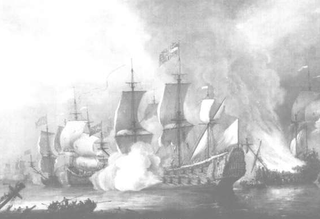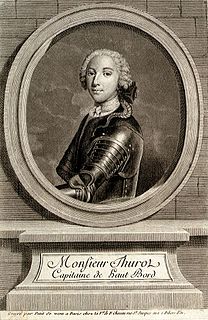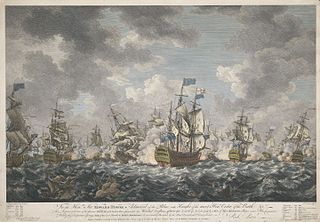| |||||
| Centuries: | |||||
|---|---|---|---|---|---|
| Decades: | |||||
| See also: | Other events of 1760 List of years in Ireland | ||||
Events from the year 1760 in Ireland.
| |||||
| Centuries: | |||||
|---|---|---|---|---|---|
| Decades: | |||||
| See also: | Other events of 1760 List of years in Ireland | ||||
Events from the year 1760 in Ireland.

The 18th century lasted from January 1, 1701 to December 31, 1800. The term is often used to refer to the 1700s, the century between January 1, 1700 and December 31, 1799. During the 18th century, elements of Enlightenment thinking culminated in the American, French, and Haitian revolutions. During the century, slave trading and human trafficking expanded on a global scale. Revolutions began to challenge the legitimacy of monarchical and aristocratic power structures, including the structures and beliefs that supported the slave trade.

1796 (MDCCXCVI) was a leap year starting on Friday of the Gregorian calendar and a leap year starting on Tuesday of the Julian calendar, the 1796th year of the Common Era (CE) and Anno Domini (AD) designations, the 796th year of the 2nd millennium, the 96th year of the 18th century, and the 7th year of the 1790s decade. As of the start of 1796, the Gregorian calendar was 11 days ahead of the Julian calendar, which remained in localized use until 1923.

1837 (MDCCCXXXVII) was a common year starting on Sunday of the Gregorian calendar and a common year starting on Friday of the Julian calendar, the 1837th year of the Common Era (CE) and Anno Domini (AD) designations, the 837th year of the 2nd millennium, the 37th year of the 19th century, and the 8th year of the 1830s decade. As of the start of 1837, the Gregorian calendar was 12 days ahead of the Julian calendar, which remained in localized use until 1923.

1760 (MDCCLX) was a leap year starting on Tuesday of the Gregorian calendar and a leap year starting on Saturday of the Julian calendar, the 1760th year of the Common Era (CE) and Anno Domini (AD) designations, the 760th year of the 2nd millennium, the 60th year of the 18th century, and the 1st year of the 1760s decade. As of the start of 1760, the Gregorian calendar was 11 days ahead of the Julian calendar, which remained in localized use until 1923.

1689 (MDCLXXXIX) was a common year starting on Saturday of the Gregorian calendar and a common year starting on Tuesday of the Julian calendar, the 1689th year of the Common Era (CE) and Anno Domini (AD) designations, the 689th year of the 2nd millennium, the 89th year of the 17th century, and the 10th and last year of the 1680s decade. As of the start of 1689, the Gregorian calendar was 10 days ahead of the Julian calendar, which remained in localized use until 1923.

1708 (MDCCVIII) was a leap year starting on Sunday of the Gregorian calendar and a leap year starting on Thursday of the Julian calendar, the 1708th year of the Common Era (CE) and Anno Domini (AD) designations, the 708th year of the 2nd millennium, the 8th year of the 18th century, and the 9th year of the 1700s decade. As of the start of 1708, the Gregorian calendar was 11 days ahead of the Julian calendar, which remained in localized use until 1923.

1701 (MDCCI) was a common year starting on Saturday of the Gregorian calendar and a common year starting on Wednesday of the Julian calendar, the 1701st year of the Common Era (CE) and Anno Domini (AD) designations, the 701st year of the 2nd millennium, the 1st year of the 18th century, and the 2nd year of the 1700s decade. As of the start of 1701, the Gregorian calendar was 11 days ahead of the Julian calendar, which remained in localized use until 1923.

1683 (MDCLXXXIII) was a common year starting on Friday of the Gregorian calendar and a common year starting on Monday of the Julian calendar, the 1683rd year of the Common Era (CE) and Anno Domini (AD) designations, the 683rd year of the 2nd millennium, the 83rd year of the 17th century, and the 4th year of the 1680s decade. As of the start of 1683, the Gregorian calendar was 10 days ahead of the Julian calendar, which remained in localized use until 1923.

Carrickfergus is a large town in County Antrim, Northern Ireland. It sits on the north shore of Belfast Lough, 11 miles (18 km) from Belfast. The town had a population of 27,998 at the 2011 Census. It is County Antrim's oldest town and one of the oldest towns in Ireland as a whole. Carrickfergus was the administrative centre for Carrickfergus Borough Council, before this was amalgamated into the Mid and East Antrim District Council in 2015, and forms part of the Belfast Metropolitan Area. It is also a townland of 65 acres, a civil parish and a barony.

Carrickfergus Castle is a Norman castle in Northern Ireland, situated in the town of Carrickfergus in County Antrim, on the northern shore of Belfast Lough. Besieged in turn by the Scottish, native Irish, English and French, the castle played an important military role until 1928 and remains one of the best preserved medieval structures in Northern Ireland. It was strategically useful, with 3/4 of the castle perimeter surrounded by water. Today it is maintained by the Northern Ireland Environment Agency as a state care historic monument, at grid ref: J4143 8725.
John Elliot was a Scottish officer of the Royal Navy who served during the Seven Years' War and the American War of Independence. He rose to the rank of admiral, and served briefly as colonial governor of Newfoundland.

The Battle of Bantry Bay was a naval engagement fought on 11 May 1689, a week before the declaration of the Nine Years' War. The English fleet was commanded by Admiral Arthur Herbert, created Earl of Torrington after the Battle; the French fleet by François Louis de Rousselet, Marquis de Châteaurenault. Apart from the inshore operations at La Rochelle in 1627–28, the Battle of Bantry Bay was the first time English and French navies had met in fleet action since 1545.
Events from the year 1765 in Great Britain.
Events from the year 1760 in Great Britain. This year sees a change of monarch.

François Thurot was a French privateer, merchant naval captain and smuggler who raided British shipping during the Seven Years' War.

Admiral Sir Thomas Pasley, 1st Baronet was a senior and highly experienced British Royal Navy officer of the eighteenth century, who served with distinction at numerous actions of the Seven Years' War, American Revolutionary War and French Revolutionary Wars. In his youth he was renowned as an efficient and able frigate officer and in later life became a highly respected squadron commander in the Channel Fleet. It was during the latter service when he was awarded his baronetcy after losing a leg at the Glorious First of June, aged 60.

A French invasion of Great Britain was planned to take place in 1759 during the Seven Years' War, but due to various factors was never launched. The French planned to land 100,000 French soldiers in Britain to end British involvement in the war. The invasion was one of several failed and defeated French attempts during the 18th century to invade Britain.

The Battle of Carrickfergus took place in February 1760 in Carrickfergus, Kingdom of Ireland during the Seven Years' War. A force of 600 French troops landed under the command of the Privateer François Thurot, overwhelmed the small garrison of the town, and captured its castle.

HMS Brilliant was a 36-gun Venus-class fifth-rate frigate of the British Royal Navy that saw active service during the Seven Years' War with France. She performed well against the French Navy in the 1760 Battle of Bishops Court and the 1761 Battle of Cape Finisterre, but was less capable when deployed for bombardment duty off enemy ports. She also captured eight French privateers and sank two more during her six years at sea. The Royal Navy decommissioned Brilliant in 1763. The Navy sold her in 1776 and she became an East Indiaman for the British East India Company (EIC). Brilliant was wrecked in August 1782 on the Comoro Islands while transporting troops to India.

The Battle of Bishops Court, also known as The Defeat of Thurot, was a naval engagement that took place 28 February 1760, during the Seven Years' War, between three British ships and three French ships. The French force under famed commander François Thurot were brought to battle in the Irish sea between the Isle of Man and the coast of Ireland at 9 am. After a close-fought action, Thurot's force was battered into submission, with his ships dismasted and reduced to a sinking condition. Thurot was shot through the heart and died during the action. The British took all three French ships, completing victory.